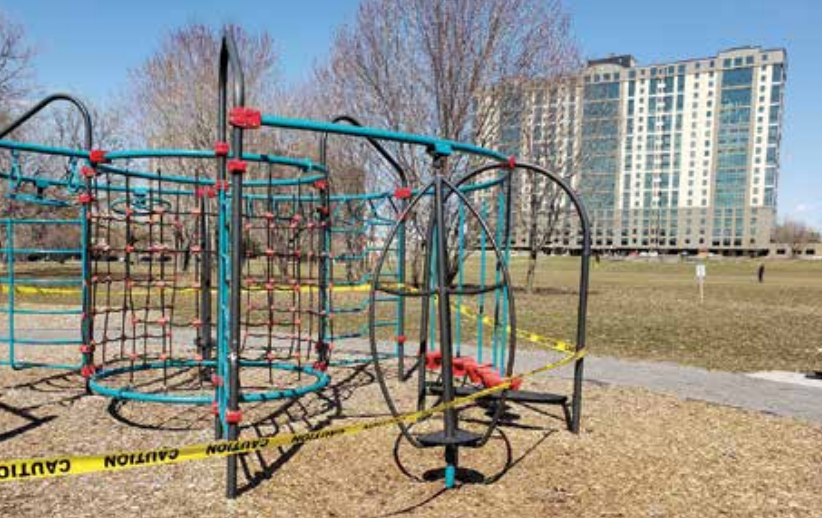
COVID-19 forced temporary closure of the Springhurst Park play structure; will the proposed Alta Vista Transportation Corridor (AVTC) prove to be the death knell for the community’s remaining public recreational spaces? OOE residents have voiced concerns to the City about retaining the AVTC in the Official Plan. Photo by Lorne Abugov
Phyllis Odenbach Sutton
Old Ottawa East residents have spotted a number of inconsistencies in the City’s draft Official Plan (OP), but none is more glaring than the disconnect between the inclusion of the Alta Vista Transportation Corridor in the OP alongside the City’s stated intention to maintain or expand green space in the inner core, mitigate climate change concerns and promote active transportation and public transit.
Anne-Raphaëlle Audouin noted in her letter to the City that “(w)e strongly request the removal of the obsolete proposal of the Alta Vista Transportation Corridor. The community needs Springhurst Park to remain a pristine green space. The construction of a four-lane roadway is an antiquated city planning proposal which goes against other City objectives, such as the reduction of transportation-related GHG emissions and the creation of more green space.”
Linda Pollock wrote: “I do not understand why the Alta Vista Transportation Corridor remains an element of the City’s Official Plan. With the huge investment that has been and is being made into the construction of the light rail system and your stated objectives to encourage sustainable mobility, why does the City continue to plan for a new roadway through existing greenspace?(…) the field between Springhurst Park and existing apartment buildings along Lees Avenue is an essential public space for people living in the area.”
John Dance was concerned that “(t)he draft retains the Alta Vista Transportation Corridor which will: provide for a four-lane roadway covering valuable central greenspaces; dump traffic into established communities, undermine the use of the new LRT system; and be in violation of what we must do to fight climate change and support biodiversity.”
For her part, Alexandra Gruca-Macaulay expressed her concerns about park planning proposals. “There has been a concerning trend (…) that has seen the installation of artificial ‘turf’ and ‘multipurpose’ paved spaces in lieu of natural grass in City parks. The potential for exacerbating or creating urban heat islands is significant – artificial turf alone has been measured to heat considerably more than natural grass and, as a plastic product, does not provide the carbon capture function of natural grass.”
Furthermore, she noted that “it is deeply concerning to see that (…) suburban areas are to be accorded opportunities for ‘recreation, sports and community programming’, whereas urban areas would see mixed-use spaces that focus on a mélange of ‘recreational uses… cultural development opportunities, [and] seating’ (…) Yet people have identical needs for recreation space. Put in simplest terms, in high-density urban areas there often is no place currently where a child can go to play, and ‘cultural development opportunities and seating’ is not going to meet this fundamental human need,” wrote Gruca-Macaulay.
And, in a community that has been celebrating our favourite trees, it should be no surprise that the need for protection of, and increase in, our tree canopy is very important to residents.
“We are particularly concerned by the environmental issues and there seems to be little mention about the tree coverings, gardens, walking space and green space around each house in the Plan,” wrote Yves and Lise Morneau in their submission to the City.
“You say you have a vision of environmentalism and all kinds of other things, which are not reflected in the plans,” Tara Wheeldon pointed out. “In terms of green space and environmentalism, it is harder to maintain tree canopy if buildings are squeezed tightly into the neighbourhood.”
Support for strengthened protection of the City’s tree canopy was voiced by several members of the Parks and Greenspace Committee of the Old Ottawa East Community Association who wrote: “While we support the City’s proposed cover target of 40% for the urban forest canopy, we ask that stronger language be put in the plan to ensure this 40% target is met on a neighbourhood-by-neighbourhood basis. Trees form an integral part of the character of Old Ottawa East and the City must ensure development occurs around them, not at their expense.
“While the City took important steps towards reaching a 40% urban tree canopy by adopting its first-ever Urban Forest Management Plan (UFMP) in 2017, more efforts are needed,” concluded the OOECA Parks and Greenspace Committee.
According to Krista Broeckx, “(t)he Draft Official Plan must support the UFMP by using stronger language and more concrete guidelines for protecting and growing the tree canopy, especially in inner urban neighbourhoods and the downtown core, which faces intense pressure from regeneration/ intensification.”






